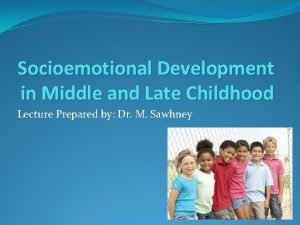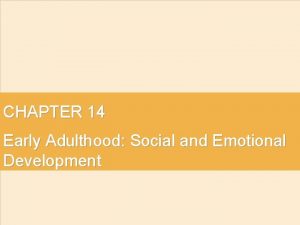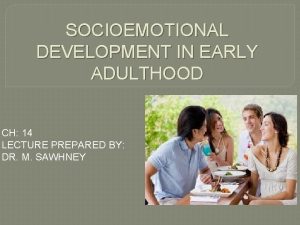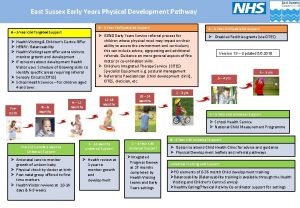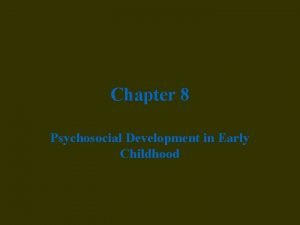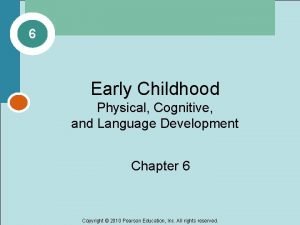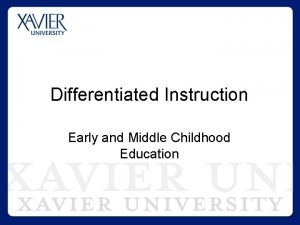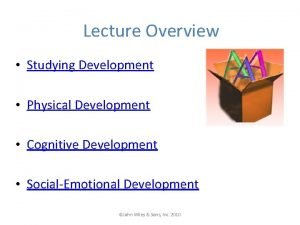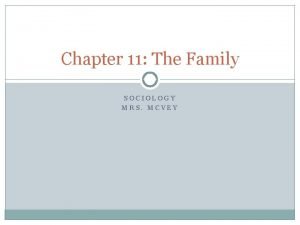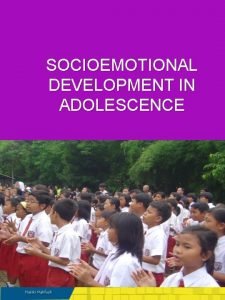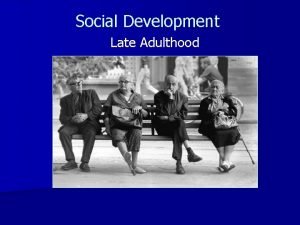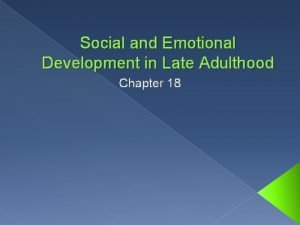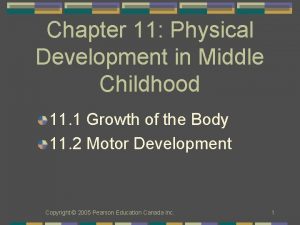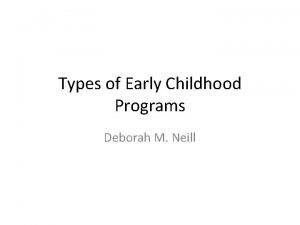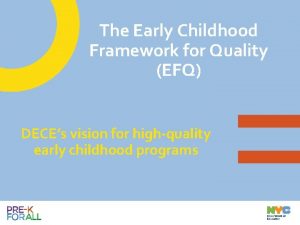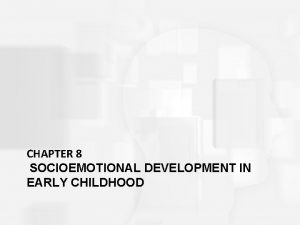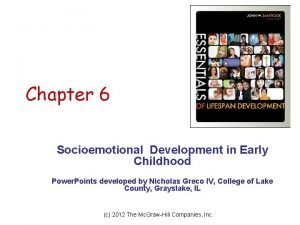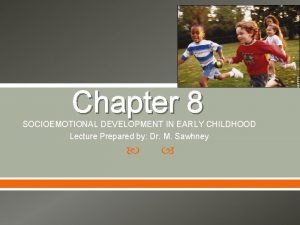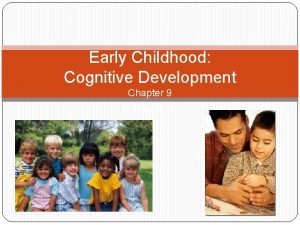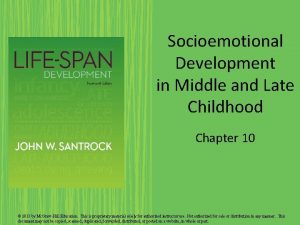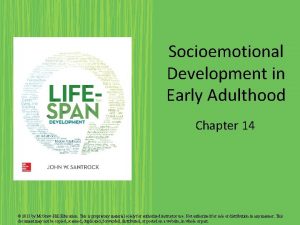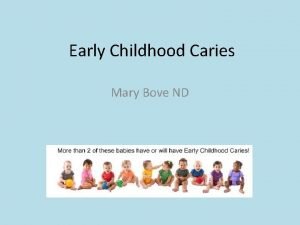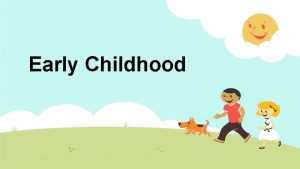Chapter 6 Socioemotional Development in Early Childhood 1
























- Slides: 24

Chapter 6 Socioemotional Development in Early Childhood 1

Learning Goals • Discuss emotional and personality development in early childhood. • Explain how families can influence young children’s development. • Describe the role of peers, play, and television in young children’s development. 2

Social development 3 years • Begin to take turns • Willing to share 4 years • • • May have imaginary companion May be selfish, impatient Takes pride in accomplishments Exaggerates or boasts Tattles on others 5 years • Talks constantly • Generally is cooperative and sympathetic towards others 3

Erikson: Initiative vs. Guilt (3 to 5 years) • Preschool children are challenged more than they were as infants. • To meet these challenges, children need to display active, purposeful behavior, such as taking care of their bodies, their toys, and their pets. • Developing a sense of responsibility increases initiative; children begin to selfregulate through observation, evaluation, and guidance of themselves. • If the child is irresponsible or not allowed opportunities to use their skills, anxiety and guilt may arise. • Preschoolers develop self-understanding based on concrete, physical differences or mastered skills. • Parents who answer their children's questions and allow opportunities to play and explore support successful resolution of the conflict between initiative and guilt. 4

Freud: Phallic stage (3 to 6 years) • Pleasure focuses on the genitals as children discover selfmanipulation is enjoyable. • Oedipus and Electra complexes are resolved by identification with same-sex parent. • Moral development is enhanced by internalizing parental and societal demands, rules, and social norms in the superego. • There is little research to support the psychoanalytic approach, but many cultural beliefs are now based upon Freud's theories. 5

Emotional Development v Children experience self-conscious emotions (e. g. , pride and guilt). v Girls are more prone to experiencing self-conscious emotions than boys. v Children from 2 to 4 years develop language to discuss emotions, their causes, and their consequences. v By 4 to 5 years, children understand that people can respond emotionally in a number of ways to the same situation. v Parents can improve children's emotional regulation by helping them label emotions and cope with their feelings. v Children with better emotional regulation skills are also more successful socially, especially with their peers. 6

Parten’s Play Categories Unoccupied play • Occurs when the child is not engaging in play as it is commonly understood and may stand in one spot, look around the room, or perform random movements that do not seem to have a goal. • In the preschool years, unoccupied play is less frequent than other forms of play. Solitary play • Child plays alone and independently of others • 2 - to 3 - years-olds engage more frequently in solitary play than older preschoolers 7

Parten’s Play Categories (con. ) Onlooker play • Child watches other children play • May talk with other children and ask questions but does not enter into their play behavior Associate play • Play involves social interaction with little or no organization • Children seem to be more interested in each other than in the tasks they are performing • Examples include borrowing or lending toys and following or leading one another in line • Social play increases dramatically during preschool years 8

Parten’s Play Categories (con. ) Parallel play • Child plays separately from others, but with toys like those the others are using or in a manner that mimics their play • Toddlers engage in this type of play more frequently than older preschoolers but even older preschoolers often engage in parallel play Cooperative play • This type of play involves social interaction in a group with a sense of group identity and organized activity. • Children's formal games, competition aimed at winning, and groups formed by the teacher for doing things together are examples of cooperative play. • Cooperative play is typical of the games of middle childhood. 9

Other Types of Play Sensorimotor play v Behavior engaged in by infants to derive pleasure from exercising their existing sensorimotor schemes v Begins at 4 -6 months of age, decreases during preschool years Practice play v Involves the repetition of behavior when new skills are being learned or when physical or mental mastery and coordination of skills are required for sports or games v Can be engaged in throughout life Pretend/symbolic play (3 -7 years) v Occurs when the child transforms the physical environment into a symbol (e. g. , playing house, make-believe) v Appears at about 18 months of age, reaches a peak at 4 to 5 years, then gradually declines 10

Other Types of Play (con. ) Social play v Involves social interaction with peers v Increases dramatically during the preschool years Constructive play (3 -6 years) v Combines sensorimotor/practice repetitive activity with symbolic representation of ideas v Occurs when children engage in self-regulated creation or construction of product or a problem solution v Increases in the preschool years as symbolic play increases and sensorimotor play decreases 11

Identification of Theory • Based on Freud's view that the preschool child develops a sexual attraction to the opposite-sex parent, then at approximately 5 to 6 years renounces this attraction because of anxiety and subsequently identifies with same-sex parent and his/her characteristics • Contradicted by findings that children become gender-typed before 5 to 6 years, even without the influence of the same-sex parent 12

Social Learning Theory of Gender • Children develop gender roles based on observations and imitation of models. • Parents, the media, peers, and culture provide models of gender roles. • Following accepted gender roles is reinforced. 13

Cognitive Development Theory • The first step in gender development is recognition of oneself as male or female. • Then, children gravitate towards those activities and roles that they perceive to represent their gender identity. 14

Gender schema theory • Schema (scheme) is a cognitive structure, organizing and structuring one's perceptions. • Gender schemes are formed by active construction of female and male concepts. • Before developing a gender construct, children must learn to use categories. • Male and female schemes are refined as individuals advance in their understanding. 15

Moral development • Feelings: gilt and anxiety • Reasoning or thinking about moral conduct • Heteronomous & Autonomous • Behaviors: to rules and social conventions • Process of reinforcement, punishment, or reward 16

Piaget's view of the development of moral reasoning Heteronomous Morality Transition Stage • This form of morality occurs • 7 to 10 years from 4 to 7 years of age. • Moral reasoning blends • Justice and rules are beliefs from preceding conceived of as and following stages. unchangeable properties of the world, removed from the control of people. • Evaluating behavior as right or wrong is based on consequences of the behavior that are perceived as automatically enforced, not the intention of the person Autonomous morality • Autonomous morality occurs at about 10 years and older. • Justice and rules are recognized as human constructions rather than absolutes. • Consequences are moderated by the intentions of the person performing the behavior. 17

Scenario 1 Jerome and Hani got up early on Saturday morning and decided to make “breakfast in bed” for their mother. While reaching for the bed tray in the back of the hall cabinet, they accidentally bumped and broke one of their mother’s favorite porcelain dolls. Jerome knew that he was going to get into “big trouble, ” and he thought that he should get into big trouble. Hani told him not to worry because Mom would understand that it was an accident. In what stage would Jean Piaget categorize the moral reasoning, respectively, of Jerome and Hani? Scenario 2 Katrina becomes extremely upset when her brother tries to change the rules of their game, yelling, “You can’t do that! You can’t change rules!” Katrina is exhibiting which of the following types of moral reasoning? Scenario 1: Jerome—heteronomous morality; Hani—autonomous morality Scenario 2: heteronomous morality 18

Moral Behavior • Behaviorists believe processes of reinforcement, punishment, and imitation provide the foundation for moral behavior. • Moral behavior is influenced extensively by situational factors. • The ability to resist temptation is closely tied to the development of the ability to delay gratification. • Cognitive development is important in the child's self-control, social reciprocity, and moral reasoning. Moral Feelings • Empathy: reacting to another's feelings with emotional response that is similar to the other's feelings; it requires the ability to take another's perspective. • Positive feelings (e. g. , empathy, sympathy, admiration, and selfesteem) and negative feelings (e. g. , anger, outrage, shame, and guilt) contribute to moral development. • Emotions help children act according to standards of right and wrong. 19

Parenting Styles Authoritarian Authoritative • Parents use firm limits and controls with little discussion or explanation; punishment is used as a consequence for noncompliance. • Children fail to develop social competence and may also develop other negative traits (e. g. , unhappiness, fearfulness, anxiety, timidity, aggression). • Parents use firm limits and controls which are explained to the child • Extensive verbal giveand-take allowed; responsibility for discipline is gradually shifted as the child develops self-control • Parents are warm and nurturing toward the child • Associated with children's social competence, cheerfulness, and selfregulation. Neglectful Indulgent • Parents • Despite being generally extremely involved ignore their with their children, children parents provide few • Associated with limits or controls. children's • Associated with social children's social incompetence, lack especially a of self control, and lack of self egocentrism control and maturity 20

Scenario 1 Suzie just brought home her report card. She earned Cs and Ds in all of her classes. When looking at the grades, her father stated, “You are an embarrassment to me! You better get those grades up, or else!” Suzie’s dad is most likely a(n)……? Scenario 2 Ursula just brought home her report card. She earned Cs and Ds in all of her classes. Ursula’s mom’s first response was “Oh, you must be very disappointed. ” Then, the two of them sat down and tried to determine why she was having difficulty and what they could do to help her get her grades up. They decided that Ursula would start seeing a tutor after school. Ursula’s mom is most likely a(n)…. . ? Scenario 3 Bernard just brought home his report card and placed it on the television set. Bernard told his dad that he was required to bring the card back to school tomorrow with the signature of one of his parents. Bernard’s dad told him to move out of the way because he could not see the TV. The next morning, Bernard found his report card where he left it, unsigned. He signed his dad’s name and put it in his backpack. Bernard’s dad is most likely a(n)…. . ? 21

Effects of divorce on children • Children experience considerable stress when their parents divorce and are at risk for developing behavior problems. • • Age and sex of children may influence their adjustment. A child’s adjustment is related to the degree of conflict. Most children of divorce develop competence. Currently, Developmentalist recognizes the changes in and diversity of family structures. 22

NATURE AND ACTIVITIES OF PEER/FRIENDSHIP GROUPS BOYS GIRLS 1. More likely to associate in larger groups. 1. More likely to associate in dyads or triads. 2. More likely to participate in organized group games and seek to attain a group goal. 2. Less likely to participate in organized group games. 3. More likely to engage in rough-andtumble play, competition, conflict, ego displays, risk taking, and seeking dominance. 3. More likely to engage in “collaborative discourse” (talking and acting in a reciprocal manner). 23

Thank You for Watching See you next time 24
 Socio-emotional development of late childhood
Socio-emotional development of late childhood Emotional growth
Emotional growth Early adulthood socioemotional development
Early adulthood socioemotional development Middle childhood is from
Middle childhood is from A vygotskian classroom promotes ________.
A vygotskian classroom promotes ________. Socioemotional development in infancy
Socioemotional development in infancy Social and emotional development in late adulthood
Social and emotional development in late adulthood Social development in middle adulthood
Social development in middle adulthood Fine motor skills development in early childhood
Fine motor skills development in early childhood Physical development in early childhood
Physical development in early childhood Psychosocial development in early childhood
Psychosocial development in early childhood Language development in early childhood
Language development in early childhood Biosocial development in early childhood
Biosocial development in early childhood Early childhood development with differentiated instruction
Early childhood development with differentiated instruction Three prenatal stages
Three prenatal stages Types of early childhood programs chapter 2
Types of early childhood programs chapter 2 Chapter 7 early childhood ages 3 through 5 answer key
Chapter 7 early childhood ages 3 through 5 answer key Socioemotional maintenance definition sociology
Socioemotional maintenance definition sociology Socioemotional changes in adolescence
Socioemotional changes in adolescence Late adulthood social development
Late adulthood social development Elders' housing preferences reflect a strong desire for
Elders' housing preferences reflect a strong desire for Physical development in middle childhood chapter 11
Physical development in middle childhood chapter 11 Types of early childhood programs
Types of early childhood programs Early childhood framework for quality
Early childhood framework for quality Efq
Efq
